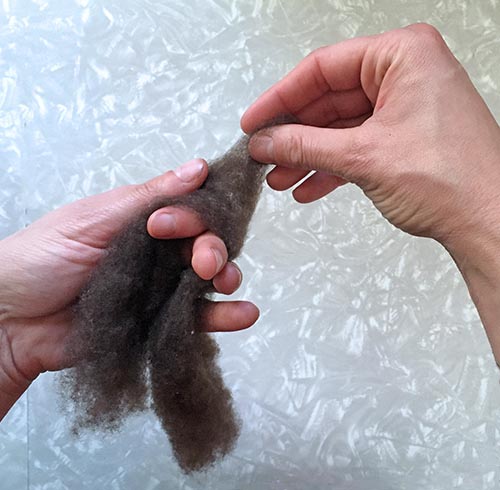The term staple length is frequently used when talking about fleece and fiber, but have you ever wondered why staple length matters and how it affects your choice of tools and techniques in a given project? In this post, we’ll tell you everything you need to know about staple length, but were afraid to ask!
What is Staple Length?
Staple length refers to the average length of the average length of a single length of fiber in its natural, unprocessed form (as it comes off the animal or plant). Natural fibers have a wide range of possible lengths depending on where they come from, whereas a continuous synthetic fiber or natural silk thread would be referred to as a filament. Fibers are generally classified as:
Short – up to 4 inches* (ex: cashmere, yak down, merino wool and some cottons)
Medium – between 3-5 inches (ex: medium wools such as Dorset, Suffolk or Cheviot)
Long – 5 inches or longer (ex: Blue Faced Leicester, Lincoln, Romney, Teeswater)
You can test the staple length of any fiber by hand by simply removing a portion of it and measuring it with a ruler; this was how staple length was determined before machinery was invented for faster and more precise measurement!
*yes, there is some overlap between short and medium staple length!
Why Staple Length Matters
Knowing the average staple length of your fleece and fiber will help you choose the right tools and techniques to get it to do what you want. Generally speaking, shorter fibers are finer and require more twist to hold together making them more challenging to work with. You can alleviate these challenges by adjusting your fiber preparation (discussed below) or blending your shorter-stapled fibers together with longer stapled components. Longer fibers can be drafted easily and generally hold together with slightly less twist, so a beginner would probably want to get their feet wet with some longwools before diving into shorter-stapled fibers such as cashmere or merino wool.
Staple Length & Processing Fibers
When it comes to processing fibers, your goal is to preserve the natural staple length as much as possible. Never cut into your fiber with scissors or a blade; if you need to separate fibers, pull from either end gently until a piece of the fiber comes away naturally.
The good news is that our drum carders are designed to be universal machines that can process the shortest, finest fibers up to the longest of longwools without damaging fibers (you can learn more about choosing & using the right drum carder for you in our free PDF guide, Drum Carding 101).
Staple Length & Handspinning
You will want to keep your hands positioned approximately a staple-length apart as you draft. For short-stapled fibers, this can be a real challenge, and that’s where fiber preparation can come into play: some folks like to turn their short-stapled fibers into punis or rolags, which allow for easier spinning using a long draw method. We have a quick tutorial on making rolags on a Strauch drum carder, found here.
Another option is to spin from the fold, a technique in which you break off a section of your combed top, fold it over your finger, and then begin drafting out fiber from the center, as shown below.
Handspinning Resources & Tutorials
Once you understand the concept of staple length, you can dig into more specific handspinning techniques. Here are some resources to bookmark:
- Long Draw Spinning
- Short Draw Spinning
- Spinning From the Fold
- 5 Tips for Handspinning a Consistent Yarn
- How to Make Rolags with a Drum Carder
We’d love to see what you’re carding and spinning over on Instagram – be sure to share your photos using the #strauchfiber hashtag!
Love this post? Pin it!



